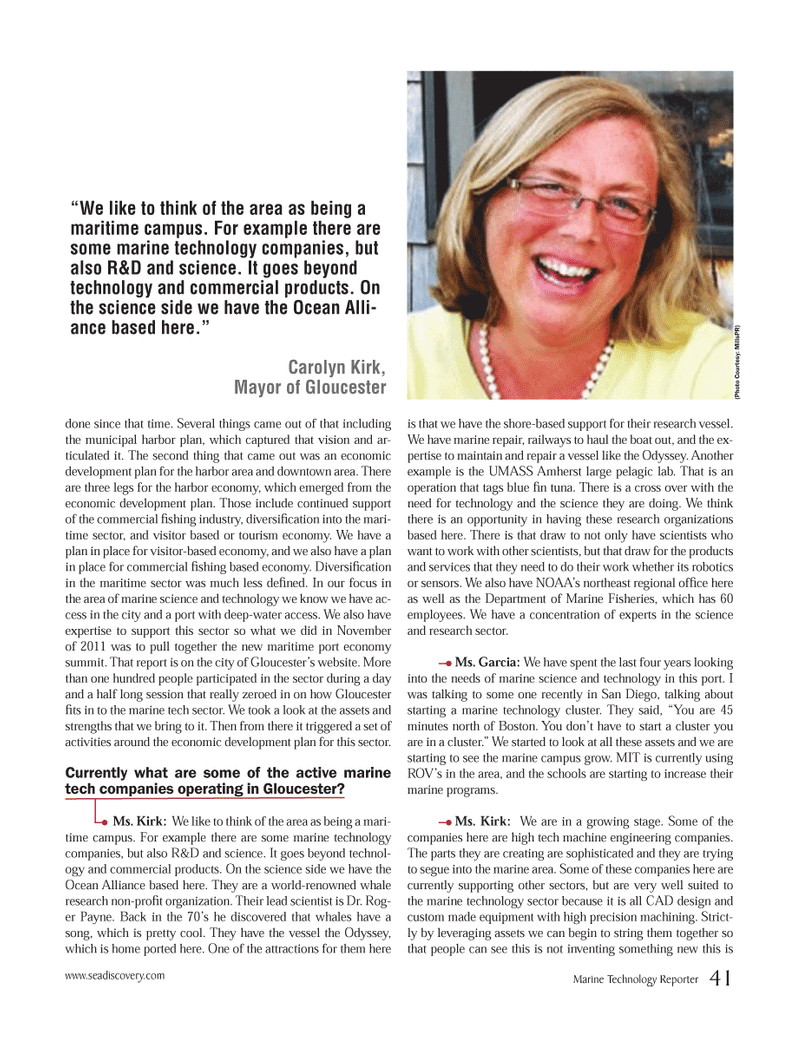
Page 41: of Marine Technology Magazine (October 2012)
Ocean Observation: Gliders, buoys & sub surface monitoring networks
Read this page in Pdf, Flash or Html5 edition of October 2012 Marine Technology Magazine
done since that time. Several things came out of that including the municipal harbor plan, which captured that vision and ar- ticulated it. The second thing that came out was an economic development plan for the harbor area and downtown area. There are three legs for the harbor economy, which emerged from the economic development plan. Those include continued support of the commercial Þ shing industry, diversiÞ cation into the mari- time sector, and visitor based or tourism economy. We have a plan in place for visitor-based economy, and we also have a plan in place for commercial Þ shing based economy. DiversiÞ cation in the maritime sector was much less deÞ ned. In our focus in the area of marine science and technology we know we have ac- cess in the city and a port with deep-water access. We also have expertise to support this sector so what we did in November of 2011 was to pull together the new maritime port economy summit. That report is on the city of GloucesterÕs website. More than one hundred people participated in the sector during a day and a half long session that really zeroed in on how Gloucester Þ ts in to the marine tech sector. We took a look at the assets and strengths that we bring to it. Then from there it triggered a set of activities around the economic development plan for this sector. Currently what are some of the active marine tech companies operating in Gloucester? Ms. Kirk: We like to think of the area as being a mari- time campus. For example there are some marine technology companies, but also R&D and science. It goes beyond technol- ogy and commercial products. On the science side we have the Ocean Alliance based here. They are a world-renowned whale research non-proÞ t organization. Their lead scientist is Dr. Rog- er Payne. Back in the 70Õs he discovered that whales have a song, which is pretty cool. They have the vessel the Odyssey, which is home ported here. One of the attractions for them here is that we have the shore-based support for their research vessel. We have marine repair, railways to haul the boat out, and the ex- pertise to maintain and repair a vessel like the Odyssey. Another example is the UMASS Amherst large pelagic lab. That is an operation that tags blue Þ n tuna. There is a cross over with the need for technology and the science they are doing. We think there is an opportunity in having these research organizations based here. There is that draw to not only have scientists who want to work with other scientists, but that draw for the products and services that they need to do their work whether its robotics or sensors. We also have NOAAÕs northeast regional ofÞ ce here as well as the Department of Marine Fisheries, which has 60 employees. We have a concentration of experts in the science and research sector. Ms. Garcia: We have spent the last four years looking into the needs of marine science and technology in this port. I was talking to some one recently in San Diego, talking about starting a marine technology cluster. They said, ÒYou are 45 minutes north of Boston. You donÕt have to start a cluster you are in a cluster.Ó We started to look at all these assets and we are starting to see the marine campus grow. MIT is currently using ROVÕs in the area, and the schools are starting to increase their marine programs. Ms. Kirk: We are in a growing stage. Some of the companies here are high tech machine engineering companies. The parts they are creating are sophisticated and they are trying to segue into the marine area. Some of these companies here are currently supporting other sectors, but are very well suited to the marine technology sector because it is all CAD design and custom made equipment with high precision machining. Strict-ly by leveraging assets we can begin to string them together so that people can see this is not inventing something new this is ?We like to think of the area as being a maritime campus. For example there are some marine technology companies, but also R&D and science. It goes beyond technology and commercial products. On the science side we have the Ocean Alli-ance based here.?Carolyn Kirk,Mayor of Gloucester (Photo Courtesy: MillsPR) www.seadiscovery.com Marine Technology Reporter 41 MTR #8 (34-49).indd 41MTR #8 (34-49).indd 4110/3/2012 10:06:21 AM10/3/2012 10:06:21 AM

 40
40

 42
42
